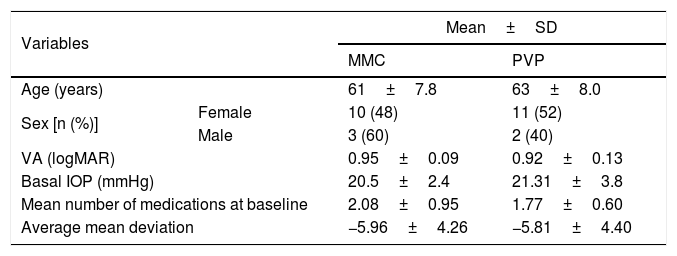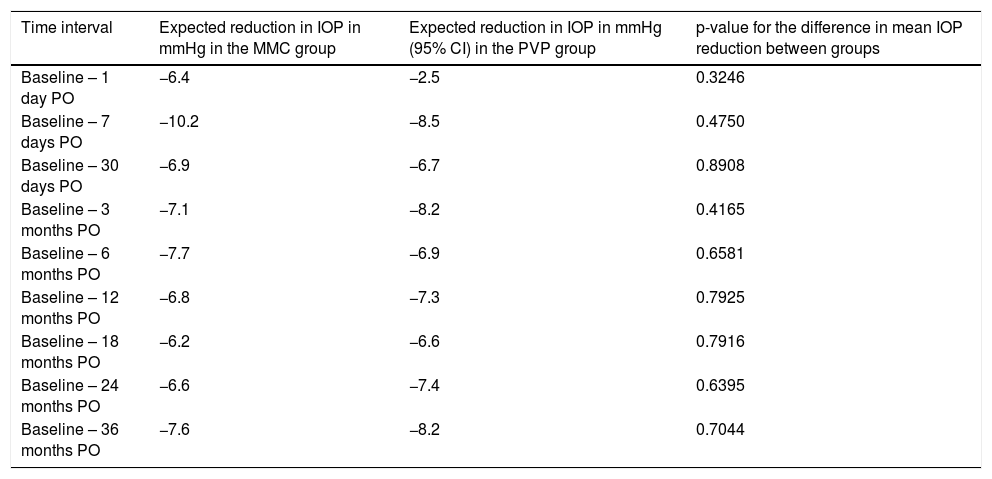Describe and compare the effects of intraoperative application of Polyvinylpyrrolidone Collagen (PVP) versus Mitomycin C (MMC) on the pattern of change in mean IOP reduction and mean number of medications over 36-months follow-up in patients with primary open angle glaucoma (POAG) undergoing trabeculectomy.
MethodsProspective, randomized, comparative study. Twenty-six eyes of 26 patients with POAG and no previous incisional glaucoma surgery underwent trabeculectomy and were randomized to PVP or MMC and completed a 36-month follow-up. Main outcome measures were IOP and number of glaucoma medications. Multivariate longitudinal analysis was performed by fitting a linear trend model adjusting for baseline response for the IOP outcome and a log-linear regression model with within-subject associations for the number of hypotensive medications outcome. Sensitivity analysis was performed to assess lower and higher order polynomial trends over time in IOP.
ResultsThe univariate analysis revealed that the mean IOP reduction from baseline to 36 months was 7.62mmHg (3.05,12.18) in the MMC group and 8.15mmHg (−0.64,16.95) in the PVP group. Mean percentage IOP reduction from baseline was 37.09% (15.93,58.17) and 36.08% (5.16,67.20) in the PVP group. Mean change in number of medications from baseline to 36 months was −0.92 medications (−3.38, +1.54)) for the MMC group and −1 medication (−3.12, +1.12). Both groups had a statistically significant decline in mean IOP over the follow-up period (p<0.001) but there was no discernible difference between the two exposure groups in the rate of change in IOP (p=0.5975). Sensitivity analysis showed that a linear trend model is adequate to describe the IOP reduction over the follow-up period. Both groups had a statistically significant change in the number of hypotensive medications used between baseline and month 36 (p<0.05) but there was no discernible difference between exposure groups (p=0.2917). Both the PVP and MMC groups showed an initial reduction in number of medications until month 12 and a relatively linear increase towards month 36. A longer follow-up may be warranted to reveal differences in the number of medications between the two exposure groups. Postoperative complications were less frequent in the PVP group.
ConclusionsThe use of PVP during trabeculectomy achieves and maintains a statistically significant IOP reduction from baseline to 36 months and decreases the number of glaucoma medications. Secondary outcome measures showed a lower incidence of adverse events in the PVP group.
Describir y comparar los efectos de la aplicación intraoperatoria de Colágeno Polivinilpirrolidona (PVP) versus Mitomicina C (MMC) en el patrón de cambio de Presión Intraocular (PIO) y número de medicamentos hipotensores utilizados en un seguimiento a 36 meses en pacientes con Glaucoma Primario de Ángulo Abierto (GPAA) operados de trabeculectomía.
MétodosEstudio prospectivo, comparativo, aleatorizado. Veintiséis ojos de 26 pacientes con diagnóstico de GPAA, sin cirugías incisionales de glaucoma previas, fueron operados de trabeculectomía y aleatorizados a recibir PVP o MMC durante el procedimiento. Todos los pacientes cumplieron un seguimiento de 36 meses. Los resultados principales medidos fueron cambios en la PIO y el número de medicamentos hipotensores durante el seguimiento.
ResultadosEl análisis multivariado reveló que la reducción de la PIO media del preoperatorio a los 36 meses se seguimiento fue de 7.62mmHg (3.05,12.18) en el grupo de MMC y de 8.15mmHg (−0.64,16.95) en el grupo de la PVP. La reducción media porcentual de la PIO fue de 37.09% (15.93,58.17) en el grupo MMC y 36.08% (5.16,67.20) en el grupo de PVP. El cambio en el número de medicamentos del preoperatorio a los 36 meses de seguimiento fue de −0.92 medicamentos (−3.38, +1.54 para el grupo de MMC y de −1 medicamentos (−3.12, +1.12) para el grupo de PVP. Ambos grupos tuvieron una disminución estadísticamente significativa de PIO durante el seguimiento (p<0.001), pero no hubo una diferencia discernible entre los grupos (p=0.5975). El análisis de sensibilidad mostró que un modelo de tendencia lineal es adecuado para describir la reducción de PIO durante el seguimiento. Ambos grupos tuvieron una reducción estadísticamente significativa de medicamentos del preoperatorio al final del seguimiento (p<0.05), tampoco hubo una diferencia discernible entre los grupos (p=0.2917). Tanto el grupo MMC como el grupo PVP tuvieron una reducción inicial en el número de medicamentos hasta el mes 12 de seguimiento y posteriormente un aumento relativamente lineal hasta el mes 36. Un seguimiento más largo es necesario para poder identificar diferencias entre ambos grupos a largo plazo. Las complicaciones postquirúrgicas fueron menos frecuentes en el grupo PVP.
ConclusionesEl uso de PVP intraoperatorio en la trabeculectomía logra y mantiene una disminución estadísticamente significativa de PIO y una disminución en el número de medicamentos hipotensores desde el preoperatorio hasta el seguimiento a 36 meses. Los resultados secundarios sugieren que existe una menor incidencia de efectos adversos en el grupo de PVP al compararlo con la MMC.














